Explore New Delhi's vibrant attractions with varying entry fees and timings. From the historic Rajghat to the iconic Red Fort, witness the architectural marvels. Shri Digambar Jain Lal Mandir offers spirituality without entry fees, while the grand Jama Masjid welcomes visitors freely. Marvel at the India Gate day or night, free of charge. Rashtrapati Bhawan, Gurudwara Bangla Sahib, and Humayun Tomb showcase diverse experiences. The Lotus Temple offers tranquility, closed on Mondays. Historical gems like Qutub Minar, National Gallery of Modern Art, and Purana Qila unfold India's rich past. Enjoy the Metro Museum, National Philatelic Museum, and Nehru Museum, each with its unique charm. Dilli Haat, a cultural bazaar, beckons with a nominal entry fee.

The Red Fort, an architectural marvel in Delhi, embodies the grandeur of the Mughal era. Constructed by Emperor Shah Jahan in the 17th century, its imposing red sandstone walls house exquisite structures that reflect a fusion of Persian, Timurid, and Indian architectural styles. The fort served as the residence of Mughal emperors for two centuries. Notable features include the Diwan-i-Aam and Diwan-i-Khas, halls for public and private audiences. A UNESCO World Heritage Site, the Red Fort holds historical significance as the site of India's first Prime Minister Jawaharlal Nehru's flag hoisting on Independence Day in 1947. Today, it stands as a symbol of India's rich cultural heritage, drawing visitors from around the world to marvel at its beauty and historical importance.
| Location | Netaji Subhash Marg, Lal Qila, Chandni Chowk, New Delhi, Delhi, 110006, India |
|---|---|
| Timing | 9.30 am to 4.30 pm |
| Entrance Fee (per person) | Adult - INR 35 (Indians), INR 550 (Foreigners) |

India Gate, a majestic war memorial in Delhi, stands as an enduring symbol of sacrifice and bravery. Built in 1931, it commemorates the soldiers of the Indian Army who gave their lives during World War I. Originally known as the All India War Memorial, its design by Sir Edwin Lutyens reflects a fusion of British and Indian architectural styles. The iconic structure, resembling the Arc de Triomphe, is surrounded by lush lawns and an eternal flame, Amar Jawan Jyoti, honoring the unknown soldiers. India Gate has become a central landmark, hosting national events and serving as a place of reflection and remembrance.
| Location | Kartavya Path, India Gate, New Delhi, Delhi 110001, India |
|---|---|
| Timing | Opens: 24 hours Boating hours: 2 PM to 9 PM Light show timings: 7 PM to 9 PM |
| Entrance Fee (per person) | No Entry Fee |
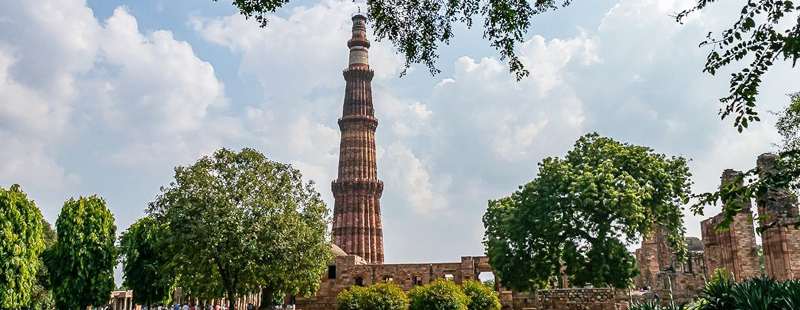
Qutub Minar, a UNESCO World Heritage Site in Delhi, India, is a towering minaret with a rich historical significance. Commissioned by Qutub-ud-din Aibak, the founder of the Delhi Sultanate, in 1192, the construction of Qutub Minar was completed by his successor Iltutmish. The minar stands as a masterpiece of Indo-Islamic architecture, reaching a height of 72.5 meters with intricate carvings and verses from the Quran. Over the centuries, several additions and renovations took place, including Firoz Shah Tughlaq's reconstruction and the addition of balconies by later rulers. Qutub Minar is surrounded by several historic structures, making it a key attraction in Delhi and a testament to the city's rich heritage.
| Location | Seth Sarai, Mehrauli, New Delhi, Delhi 110030, India |
|---|---|
| Timing | 7:00 am to 5:00 pm; every day |
| Entrance Fee (per person) | INR 30 for Indians; INR 500 for foreigners; free for children below 15 years |
| Still Camera | 25 - 50 INR(non-commercial use) |
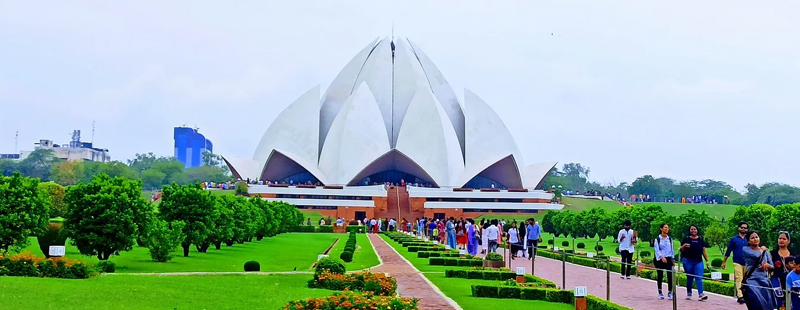
The Lotus Temple, located in Delhi, India, is a Bahá'í House of Worship renowned for its distinctive lotus flower-inspired design. Completed in 1986, it was designed by Iranian architect Fariborz Sahba. The temple's lotus shape symbolizes purity and the universality of the Bahá'í Faith, which emphasizes the unity of all people and religions. The structure is composed of 27 free-standing marble-clad "petals" arranged in clusters, forming nine sides. The Lotus Temple is open to people of all faiths, providing a tranquil space for prayer, meditation, and reflection. It has become an architectural marvel and an emblem of India's cultural and religious diversity.
| Location | THIKARYA BALAJI KAJALA BAVAN, Theekariya, Rajasthan 302026, India |
|---|---|
| Timing | 9:00 am to 5:00 pm; every day |
| Entrance Fee (per person) | Free |
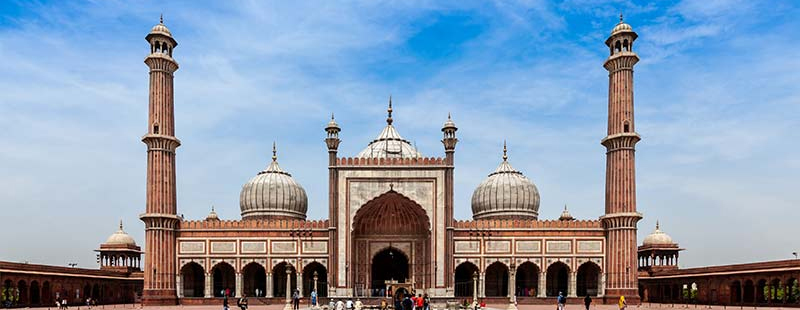
Commissioned by Emperor Shah Jahan, the construction of Jama Masjid in Delhi began in 1650 and concluded in 1656. This architectural masterpiece stands as one of India's largest mosques, showcasing a harmonious blend of Persian, Timurid, and Indian design elements. Positioned atop a raised platform, the mosque features three majestic domes, two towering minarets, and four ornate towers. The grand courtyard accommodates a vast congregation, while the central prayer hall boasts intricate marble and red sandstone embellishments. The Buland Darwaza, the mosque's main entrance, adds to its imposing presence. Jama Masjid has retained its historical and religious significance, serving as a revered place of worship and a symbol of Mughal architectural prowess. Visitors are drawn not only to its spiritual ambiance but also to the awe-inspiring beauty that defines this iconic structure in the heart of Old Delhi.
| Location | Jama Masjid, Old Delhi, Delhi, 110006, India |
|---|---|
| Timing | 7:00 am to 12:00 pm and 1:30 pm to 6:30 pm; every day (tourists not allowed during the prayer hours) |
| Entrance Fee (per person) | Free |
| Camera | INR 300 ticket price for photography. |
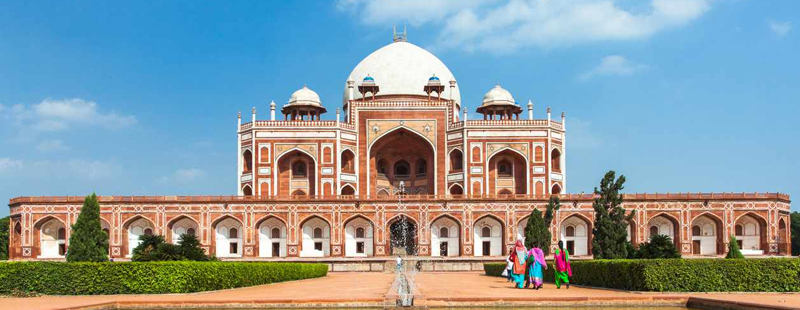
Humayun's Tomb, a masterpiece of Mughal architecture in Delhi, was commissioned by Empress Bega Begum in memory of her husband, Mughal Emperor Humayun. Constructed between 1569 and 1572, the tomb is an early example of the garden tomb concept that reached its pinnacle with the Taj Mahal. Designed by Mirak Mirza Ghiyas, a Persian architect, the tomb's grandeur lies in its symmetrical layout, high arches, and the iconic white marble dome. Surrounded by lush gardens, water channels, and pathways, the tomb complex creates a serene and harmonious atmosphere. The intricate details of geometric patterns, calligraphy, and lattice work on the walls showcase the artistic finesse of Mughal craftsmanship. Humayun's Tomb stands as a testament to the enduring legacy of Mughal architecture and remains a UNESCO World Heritage Site, attracting visitors with its historical and aesthetic significance.
| Location | Hazrat Nizamuddin Aulia Dargah, Mathura Rd, Nizamuddin, Nizamuddin East, New Delhi, Delhi 110013, India |
|---|---|
| Timing | 6:00 AM to 7:00 PM. |
| Entrance Fee (per person) | INR 30 for Indians; INR 500 for foreigners; free for children below 15 years |
| Camera | INR 25 fee for videography. |
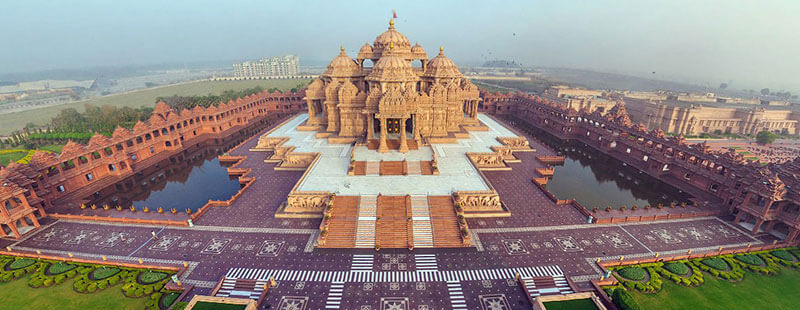
Akshardham Temple, a breathtaking testament to India's cultural and spiritual grandeur, graces Delhi's landscape since its inauguration in 2005. Affiliated with the Swaminarayan Akshardham organization, the temple pays homage to Bhagwan Swaminarayan. Crafted from pink sandstone and white marble, the central mandir boasts intricate carvings, embodying divine artistry.
More than a religious edifice, Akshardham unfolds as a cultural complex. Exhibitions, the Yagnapurush Kund, Sahaj Anand Water Show, and the Yogi Hraday Kamal converge, offering a profound and immersive experience. This spiritual sanctuary, promoting harmony and cultural awareness, transcends its architectural brilliance. Visitors from across the globe are drawn to Akshardham, not only for its visual magnificence but also for the cultural and spiritual enrichment it imparts, making it an indelible symbol of India's rich heritage.
| Location | Noida Mor, Pandav Nagar, New Delhi, Delhi, 110092, India |
|---|---|
| Timing | 9:30 AM to 6:30 PM |
| Temple Entry Fee | Free |
| Exhibition Fee | INR 250 for adults (12 years and above); INR 200 for senior citizens (60 years and above); INR 150 for children (4 to 11 years); free for children below 4 years |
| Camera | INR 25 fee for videography. |
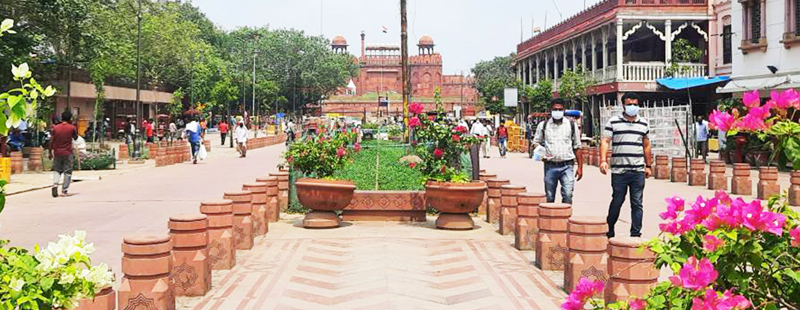
Chandni Chowk, established in 1650 by Emperor Shah Jahan, is one of Delhi's oldest and busiest markets. Originally designed as the central street of Shahjahanabad, the walled city of the Mughal Empire, it showcased the opulence of the Mughal era. The name "Chandni Chowk" refers to the moonlight's reflection in a central pool that once adorned the market.
| Location | Chandni Chowk, Delhi, 110006, India |
|---|---|
| Timing | 9:30 am – 8:00 pm |
| Temple Entry Fee | Free |
The Shri Digambar Jain Lal Mandir, located in the heart of Delhi, stands as a venerable testament to Jain spirituality and architectural elegance. With an entry fee graciously set at zero, the temple invites devotees and curious visitors alike to explore its sacred premises.
In the summer months, the temple opens its doors from 5:30 AM to 11:30 PM, with an evening session from 6:00 PM to 9:30 PM. During the winter season, the timings shift slightly, from 6:00 AM to 11:00 PM in the morning and 5:30 PM to 09:00 PM in the evening.
Steeped in history, this Jain temple boasts a legacy dating back to the 17th century, making it the oldest of its kind in Delhi. Its distinctiveness lies in the striking red hue of its architecture, a visual emblem of spiritual devotion. Visitors are not just welcomed into a place of worship but also into a living testament of cultural and religious continuity. The Shri Digambar Jain Lal Mandir, with its serene ambiance and historical resonance, remains a beacon of tranquility and reverence in the bustling heart of Delhi, inviting all to connect with the spirituality and heritage it embodies.
Rashtrapati Bhawan, a regal masterpiece nestled in the heart of New Delhi, offers a glimpse into the nation's governance and architectural splendor. Open to the public without any entry fee, it stands as a symbol of democratic transparency.
The timings for visitors are from 9:30 AM to 5:30 PM, providing an opportunity to explore the magnificence of the residence. However, it is prudent to check for closures during Presidential movements.
Formerly known as the Viceroy's House, this iconic structure serves as the official residence of the President of India. Conceived by the eminent architect Sir Edwin Lutyens, Rashtrapati Bhawan is an architectural marvel, reflecting a harmonious blend of Indian and Western styles. Its sprawling gardens and grandeur encapsulate the nation's democratic ethos and historical legacy, making it a must-visit destination for those seeking to witness the embodiment of India's political and architectural heritage.
Gurudwara Bangla Sahib, a sacred haven in the heart of Delhi, beckons devotees and seekers of serenity with its open doors and free entry. Open 24 hours a day, the suggested visiting hours, from 5:00 AM to 10:00 PM, ensure a tranquil experience amidst the spiritual aura.
This prominent Sikh gurdwara holds profound historical significance, intimately linked with the eighth Sikh Guru, Guru Har Krishan. The gurdwara stands on the site where Guru Har Krishan stayed during his visit to Delhi in the 17th century. Its gleaming golden dome and serene Sarovar (sacred pool) create an atmosphere of tranquility and devotion.
Gurudwara Bangla Sahib is not merely a place of worship but a symbol of communal harmony, providing langar (free community kitchen) to visitors of all backgrounds. It stands as a testament to the Sikh values of selfless service, equality, and compassion, inviting all to partake in the spiritual richness it exudes.
The National Gallery of Modern Art (NGMA) in Delhi, an enriching cultural enclave, charges Rs 20 for Indian visitors and Rs 500 for foreigners to explore its diverse artistic treasury. Closed on Mondays, the gallery warmly welcomes art enthusiasts on the remaining days from 10:00 AM to 5:00 PM.
Steeped in history, NGMA serves as a custodian of India's artistic evolution, boasting an extensive collection of modern and contemporary art by Indian maestros. From pioneering strokes of Raja Ravi Varma to avant-garde expressions of contemporary artists, the gallery provides a kaleidoscopic journey through India's artistic legacy.
The architectural grandeur of NGMA complements the vibrancy within, creating a space where visual narratives intertwine with historical threads. It stands not just as a repository of art but as a testament to the ceaseless creativity that defines India's cultural tapestry, beckoning visitors to immerse themselves in the dynamic narratives painted by the nation's artistic visionaries.
Nizamuddin Dargah, a sacred haven in Delhi, opens its gates freely to seekers of spiritual solace. From the early hours of 5:00 AM to the tranquility of 11:30 PM, the dargah invites devotees to experience its serene ambiance.
Enveloped in history, the dargah is the sacred shrine of the revered Sufi saint, Nizamuddin Auliya. Its spiritual resonance echoes through the ages, drawing pilgrims and enthusiasts alike. The atmosphere comes alive with the soul-stirring melodies of qawwali performances, captivating hearts and fostering a sense of divine connection.
The dargah stands not just as a monument but as a living testament to the Sufi traditions that emphasize love, tolerance, and unity. Pilgrims and visitors alike are welcomed into a realm where spirituality transcends boundaries, and the rhythmic echoes of devotion create an ethereal tapestry of cultural and religious harmony. Nizamuddin Dargah beckons all to partake in the spiritual journey it offers, an immersion into the timeless grace of Sufi mysticism.
Jantar Mantar, an architectural marvel nestled in Delhi, invites astronomy enthusiasts and curious minds to explore its celestial wonders. The entry fees stand at Rs 5 for Indian visitors and Rs 200 for foreigners, unlocking a gateway to the mysteries of the cosmos. The observatory welcomes visitors daily from 6:00 AM to 6:00 PM.
Crafted in the 18th century by Maharaja Jai Singh II, Jantar Mantar is a testament to ancient astronomical prowess. Amidst its expansive grounds, colossal instruments stand tall, designed for precise observations of celestial movements. The sundials, astrolabes, and celestial globes showcase the ingenuity of Jai Singh II, aligning with his passion for astronomy and the quest for cosmic understanding.
Jantar Mantar, designated as a UNESCO World Heritage Site, not only serves as a historical artifact but as a living testament to India's scientific heritage. It invites all to marvel at the intersection of art, science, and the cosmos, bridging the gap between ancient wisdom and contemporary fascination.
Connaught Place Market, a bustling nexus of commerce and culture in Delhi, unfolds its vibrant tapestry without any entry fee. From the early hours of 9:00 AM to the evening bustle until 8:00 PM, this iconic market beckons shoppers and explorers alike.
Designed in a distinctive horseshoe shape, Connaught Place is a testament to urban planning brilliance. Named after the Duke of Connaught, the market's history is interwoven with Delhi's colonial past. It emerged as a commercial hub, adorned with Georgian-style architecture and a circular layout that houses a plethora of shops, restaurants, and cultural spaces.
Connaught Place Market is not merely a shopping destination but a living testament to Delhi's dynamic spirit. It has witnessed the evolution of trends, the ebb, and flow of commerce, and the diverse energies of the city's denizens. With its historic charm and contemporary allure, Connaught Place remains a timeless rendezvous, inviting all to immerse themselves in the pulsating heart of Delhi's commerce and culture.
Purana Qila, the venerable Old Fort, stands as a testament to India's historical continuum, inviting visitors to traverse its storied grounds. Entry fees, set at Rs 20 for Indians and Rs 200 for foreigners, grant access to this archaeological gem. The fort unfolds its historical tableau from 7:00 AM to 5:00 PM.
Dating back to the 16th century, Purana Qila is steeped in antiquity and echoes with the whispers of bygone eras. Its grandeur has witnessed the rise and fall of empires, becoming a silent witness to Delhi's evolution. The fort's architectural splendor, marked by massive walls and imposing gates, adds to its allure.
Beyond its aesthetic charm, Purana Qila's archaeological significance is evident in its excavations that unearth artifacts spanning centuries. The fort not only stands as a visual spectacle but also as a living repository of Delhi's layered history, beckoning all to immerse themselves in the enigmatic narratives etched within its timeworn stones.
Agrasen ki Baoli, an architectural marvel nestled in Delhi, unfolds its ancient allure without any entry fee. From 9:30 AM to 5:00 PM, visitors are welcomed to explore the mystique of this historic stepwell.
Steeped in history, Agrasen ki Baoli is believed to trace its origins to the Mahabharata era, attributed to the legendary Maharaja Agrasen. Its architectural magnificence is accentuated by a series of steps descending into the depths of the well, creating a visual spectacle that resonates with echoes of antiquity.
Beyond its structural splendor, the baoli holds an enigmatic charm, evoking tales of bygone civilizations and the timeless allure of water as a source of life. The tranquil ambiance and architectural precision make Agrasen ki Baoli not just a historical relic but a living testament to the enduring legacy of Delhi's cultural and architectural heritage. Visitors are invited to step into the past, where each stone whispers tales of a bygone era, preserving the essence of Maharaja Agrasen's legacy in this subterranean marvel.
The Metro Museum, a portal into the evolution of Delhi Metro, invites visitors with a modest entry fee of Rs 8 per person. From 10:00 AM to 4:00 PM, the museum unveils the history and development of the city's lifeline through engaging exhibits and displays.
With no entry fee and open from 10:00 AM to 5:00 PM (closed on weekends), the National Philatelic Museum unfolds the world of philately. Dedicated to postage stamps and related artifacts, it curates a historical journey through these miniature masterpieces.
For a nominal fee of Rs 5 for adults and Rs 2 for children, the Nehru Museum pays homage to Jawaharlal Nehru, India's first Prime Minister. Open from 11:00 AM to 7:00 PM, it showcases the life and contributions of this visionary leader.
Dilli Haat, a cultural and handicrafts haven, invites all for a Rs 10 entry fee. Open from 11:00 AM to 9:00 PM, it showcases a diverse array of crafts, cuisine, and cultural activities from different Indian states, weaving a vibrant tapestry of India's rich heritage.